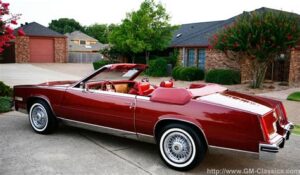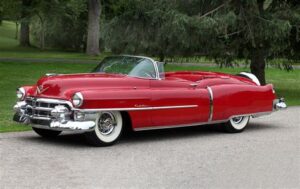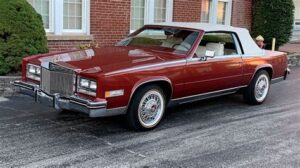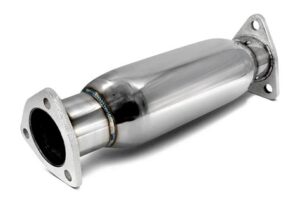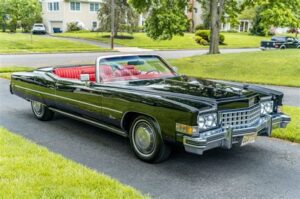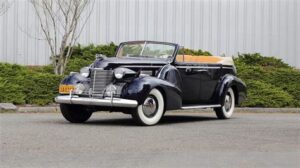Title: 1976 Cadillac Convertible: A Timeless Classic
The 1976 Cadillac Convertible stands as a beacon of luxury and style from an iconic era in automotive history. Renowned for its smooth lines and opulent features, this classic vehicle captures the essence of American automotive craftsmanship. As we delve into the features that define this model, explore its significance within the larger historical context, and discuss popular modifications, maintenance tips, and restoration techniques, you’ll discover why the 1976 Cadillac Convertible remains a sought-after collector’s item. Whether you’re a proud owner or an enthusiast dreaming of restoration, this guide will provide valuable insights to help you appreciate and maintain this distinguished automobile. Join us in celebrating this magnificent piece of automotive heritage!
Overview Of The 1976 Cadillac Convertible Features
The 1976 Cadillac convertible stood out among its contemporaries with a range of luxurious features and innovative technologies. Below is an overview of what made this vehicle a standout during its era:
| Feature | Description |
|---|---|
| Engine | Powered by a robust 500 cubic inch (8.2 L) V8 engine, delivering an impressive 190 horsepower, making it one of the most powerful engines offered in that time. |
| Exterior | Classic Cadillac styling with elongated body lines, a massive front grille, and distinctive tail lights, encapsulating the luxurious aesthetics of the brand. |
| Interior | Sumptuous leather upholstery, spacious seating for up to six passengers, and a custom wood-grain dashboard, providing comfort and elegance. |
| Technology | Equipped with advanced features for its time, including power windows, automatic climate control, and a premium sound system. |
| Ride Quality | Famous for its smooth ride, the 1976 Cadillac convertible featured an advanced suspension system that absorbed bumps effortlessly, ensuring a luxurious driving experience. |
In addition to these features, the 1976 Cadillac convertible was known for its variety of color options and interior trims, allowing buyers to customize their vehicles to their preferences. This model epitomized the luxury and boldness that Cadillac was renowned for in the automotive landscape during the 1970s.
Significance Of The 1976 Cadillac In Automotive History
The 1976 Cadillac convertible holds a prominent place in automotive history, representing the end of an era for American luxury cars. As one of the last full-size convertibles produced by Cadillac, its discontinuation marked the conclusion of a significant chapter for a brand synonymous with opulence and craftsmanship.
Cadillac, a division of General Motors, was renowned for its commitment to excellence, and the 1976 Cadillac convertible exemplified this tradition. Featuring sleek lines, a powerful engine, and lavish interiors, it was designed for those who appreciated the finer things in life. This model was unique not only for its luxurious appeal but also for its engineering, showcasing the high standards of the American automobile industry during the mid-20th century.
The 1976 Cadillac convertible also signified a shift in consumer preferences. The late 1970s saw a growing interest in fuel efficiency and compact cars due to rising fuel prices and changing societal norms. Consequently, this model became a collector’s item, cherished for its size and style rather than practicality. It remains a symbol of American automotive history, capturing the spirit of a time when cruising down the boulevard in a convertible represented ultimate freedom.
The significance of the 1976 Cadillac convertible extends beyond its design and luxury; it encapsulates a pivotal moment in the automotive landscape, reminding enthusiasts and collectors alike of the grandeur that once defined American cars.
Common Modifications For The 1976 Cadillac Convertible
The 1976 Cadillac Convertible is a classic car that many enthusiasts love to modify for better performance and aesthetics. While the original design is iconic, various modifications can enhance the driving experience, style, and overall value. Here are some popular modifications that can be done:
- Engine Upgrades: Many owners opt for engine enhancements, such as installing a performance carburetor or upgrading the ignition system. These modifications can improve throttle response and overall horsepower.
- Improved Suspension: Upgrading the suspension system with modern shocks, springs, and sway bars can significantly enhance handling and ride comfort, making the 1976 Cadillac more enjoyable to drive.
- Braking System Enhancements: Installing larger brake calipers or upgrading to disc brakes can improve stopping power, a crucial modification considering the original braking systems may not be as effective by today’s standards.
- Classic to Modern Wheels: Changing out the stock wheels for a set of alloy or custom-designed rims can significantly change the car’s look. Ensure the wheels are compatible with the suspension and brake modifications.
- Interior Upgrades: Many enthusiasts rejuvenate the interiors with modern upholstery materials, new carpet, or an upgraded sound system while maintaining a classic feel.
- Exhaust System Modifications: Installing a high-performance exhaust system can enhance the sound of the 1976 Cadillac and improve engine efficiency.
- Paint and Body Work: A fresh coat of paint or body modifications can restore the car’s original luster or create a unique look that stands out at car shows.
- Adding Technology: Installing modern conveniences like Bluetooth connectivity, GPS navigation, or upgraded classic-style infotainment systems allows you to enjoy modern amenities while retaining the classic atmosphere.
Each modification should be carefully considered to maintain the balance between enhancing performance, comfort, and the classic essence that makes the 1976 Cadillac Convertible so beloved. With the right tweaks, you can preserve its historical value while allowing for a more personalized driving experience.
Maintenance Tips For Keeping Your 1976 Cadillac Convertible Pristine
Owning a classic car like the 1976 Cadillac convertible is a prestigious experience, but it also comes with the responsibility of proper maintenance. To ensure that your vehicle remains in excellent condition for years to come, consider the following tips:
| Maintenance Task | Frequency | Tips |
|---|---|---|
| Oil Change | Every 3,000-5,000 miles | Use high-quality oil to maintain engine health. |
| Tire Inspection | Monthly | Check for uneven wear and maintain proper tire pressure. |
| Battery Check | Annually | Clean terminals and ensure connections are tight. |
| Fluid Levels | Monthly | Regularly check coolant, brake, and transmission fluids. |
| Waxing | Every 3 months | Use high-quality wax to protect the paint and finish. |
In addition to routine maintenance, here are some additional tips specifically tailored for the 1976 Cadillac:
- Preserve the Interior: Use leather conditioner and sunshades to keep the upholstery in top condition.
- Rust Prevention: Inspect the undercarriage regularly and apply rust-proofing if necessary.
- Engine Care: Consider regular tune-ups to keep the engine running smoothly and efficiently.
- Storage: If storing for an extended period, use a breathable car cover to protect from dust and moisture.
By following these tips, you’ll help maintain the beauty and performance of your 1976 Cadillac convertible, ensuring it remains a cherished classic for many years to come.
How To Restore A 1976 Cadillac Convertible For Optimal Performance
Restoring a 1976 Cadillac convertible can be a rewarding project for automotive enthusiasts. This classic vehicle, known for its elegance and performance, requires careful attention to ensure it operates as smoothly as it did when it first hit the road. Below are key steps and considerations to help guide you through the restoration process:
1. Evaluate the Condition: Begin by thoroughly inspecting your 1976 Cadillac. Check for rust, body damage, and the overall state of the frame. Take note of the condition of the engine, transmission, and electrical systems, as these will affect the restoration approach.
2. Source Original Parts: Authenticity is important for classic cars. Whenever possible, source original parts or high-quality reproductions to maintain the vehicle’s integrity. Online marketplaces, salvage yards, and classic car shows are great places to find what you need.
3. Engine Overhaul: A key component of restoration is ensuring the engine is in top shape. This may involve replacing worn out components such as gaskets, seals, and spark plugs. Consider a full rebuild if the engine shows significant wear or damage.
4. Suspension and Brakes: Pay attention to the suspension and braking systems. Replacing old shocks, struts, and brake pads can improve handling and safety. Upgrading to modern braking systems can also enhance stopping power and responsiveness.
5. Exterior Restoration: Restore the body by addressing any rust or dents and repainting with quality automotive paint. Don’t forget to take care of chrome parts, which can often be re-plated to look as good as new.
6. Interior Restoration: Revitalizing the interior is crucial for comfort and aesthetics. Replace or refurbish seats, dashboards, and carpeting. Upgrading the sound system while keeping the original look can also enhance the driving experience.
7. Electrical System Check: Ensure that the wiring, lights, and gauges are functioning correctly. Rewiring may be needed, especially if the original wiring is frayed or damaged.
8. Regular Maintenance Routines: Post-restoration, establish a regular maintenance routine to keep your 1976 Cadillac operating optimally. Regular oil changes, brake checks, and fluid level monitoring are essential.
9. Join a Community: Engaging with classic car communities can provide valuable tips and support. Enthusiasts can share their restoration experiences, which can help you navigate any challenges you face.
10. Document the Process: Keep detailed records of the restoration process, including photos, parts used, and any modifications made. This documentation will not only enhance the value of the vehicle but also give future owners insight into the care it has received.
By following these steps, you can restore your 1976 Cadillac convertible for optimal performance, ensuring it remains a stunning piece of automotive history for years to come.
Frequently Asked Questions
What are the defining features of the 1976 Cadillac convertible?
The 1976 Cadillac convertible is known for its elegant design, plush interior, and powerful V8 engine. It features a long hood, wide stance, and luxurious details like leather seats and premium wood trim.
Why is the 1976 Cadillac convertible considered a classic?
This model is regarded as a classic due to its iconic styling, status during the golden age of American automobiles, and its representation of luxury and comfort of that era. Fewer convertibles were produced in later years, adding to its allure.
What is the engine specification of the 1976 Cadillac convertible?
The 1976 Cadillac convertible typically came with a 500 cubic inch (8.2 liters) V8 engine, producing approximately 190 horsepower, which provided a smooth yet powerful driving experience.
What are some common issues with the 1976 Cadillac convertible?
Common issues may include electrical problems, rust in the body or frame, and wear on the interior materials. Regular maintenance and proper care can help mitigate these issues.
What was the price range for a 1976 Cadillac convertible when it was first released?
When first released, the price of a 1976 Cadillac convertible ranged from approximately $8,500 to $10,000, making it a premium vehicle at the time.
How does the 1976 Cadillac convertible compare to other convertibles from the same era?
Compared to other convertibles of its time, the 1976 Cadillac is celebrated for its luxurious features, spaciousness, and performance. It often stands out due to its distinctive styling and reputation for comfort.
What is the current market value of a 1976 Cadillac convertible?
The current market value of a 1976 Cadillac convertible can vary widely based on condition and mileage but typically ranges from $10,000 to $30,000, with well-maintained models fetching higher prices.
